Investigation of Micromorphology and Carrier Recombination Dynamics for InGaN/GaN Multi-Quantum Dots Grown by Molecular Beam Epitaxy
Abstract
:1. Introduction
2. Experiments
2.1. Growth of InGaN MQDs Structure
2.2. Measurements of Micromorphology and Optical Properties
3. Results and Discussion
Carrier Recombination Dynamics of InGaN/GaN MQDs
4. Conclusions
Author Contributions
Funding
Data Availability Statement
Acknowledgments
Conflicts of Interest
References
- DenBaars, P.S.; Feezell, D.; Kelchner, K.; Pimputkar, S.; Pan, C.; Yen, C.; Tanaka, S.; Zhao, Y.; Pfaff, N.; Farrell, R.; et al. Development of Gallium-Nitride-Based Light-Emitting Diodes (Leds) and Laser Diodes for Energy-Efficient Lighting and Displays. Acta Mater. 2013, 61, 945–951. [Google Scholar] [CrossRef]
- Jansen, M.; Carey, G.P.; Carico, R.; Dato, R.; Earman, A.M.; Finander, M.J.; Giaretta, G.; Hallstein, S.; Hofler, H.J.S.; Kocot, C.P.; et al. Visible laser sources for projection displays. Proj. Disp. XII 2007, 6489, 648908. [Google Scholar] [CrossRef]
- Mukai, T.; Nagahama, S.; Kozaki, T.; Sano, M.; Morita, D.; Yanamoto, T.; Yamamoto, M.; Akashi, K.; Masui, S. Current Status and Future Prospects of Gan-Based Leds and Lds. Phys. Stat. Sol. 2004, 201, 2712–2716. [Google Scholar] [CrossRef]
- Nakamura, S.; Senoh, M.; Nagahama, S.; Iwasa, N.; Yamada, T.; Matsushita, T.; Sugimoto, Y.; Kiyoku, H. Room-Temperature Continuous-Wave Operation of InGaN Multi-Quantum-Well Structure Laser Diodes. Appl. Phys. Lett. 1996, 69, 4056–4058. [Google Scholar] [CrossRef]
- Wu, T.; Sher, C.-W.; Lin, Y.; Lee, C.-F.; Liang, S.; Lu, Y.; Chen, S.-W.H.; Guo, W.; Kuo, H.-C.; Chen, Z. Mini-LED and Micro-LED: Promising Candidates for the Next Generation Display Technology. Appl. Sci. 2018, 8, 1557. [Google Scholar] [CrossRef] [Green Version]
- Nippert, F.; Karpov, S.Y.; Callsen, G.; Galler, B.; Kure, T.; Nenstiel, C.; Wagner, M.R.; Straßburg, M.; Lugauer, H.-J.; Hoffmann, A. Temperature-Dependent Recombination Coefficients in InGaN Light-Emitting Diodes: Hole Localization, Auger Processes, and the Green Gap. Appl. Phys. Lett. 2016, 109, 161103. [Google Scholar] [CrossRef] [Green Version]
- Saito, S.; Hashimoto, R.; Hwang, J.; Nunoue, S. InGaN Light-Emitting Diodes On c-Face Sapphire Substrates in Green Gap Spectral Range. Appl. Phys. Express 2013, 6, 111004. [Google Scholar] [CrossRef]
- Romanov, A.E.; Baker, T.J.; Nakamura, S.; Speck, J.S. Strain-Induced Polarization in Wurtzite Ⅲ-Nitride Semipolar Layers. J. Appl. Phys. 2006, 100, 023522. [Google Scholar] [CrossRef] [Green Version]
- Cho, H.K.; Lee, J.Y.; Kim, C.S.; Yang, G.M. Influence of strain relaxation on structural and optical characteristics of InGaN/GaN multiple quantum wells with high indium composition. J. Appl. Phys. 2002, 91, 1166–1170. [Google Scholar] [CrossRef]
- Yang, D.; Wang, L.; Hao, Z.-B.; Luo, Y.; Sun, C.; Han, Y.; Xiong, B.; Wang, J.; Li, H. Dislocation analysis of InGaN/GaN quantum dots grown by metal organic chemical vapor deposition. Superlattices Microstruct. 2016, 99, 221–225. [Google Scholar] [CrossRef]
- Zhao, W.; Wang, L.; Lv, W.; Wang, L.; Wang, J.; Hao, Z.; Luo, Y. Growth Behavior of High-Indium-Composition InGaN Quantum Dots Using Growth Interruption Method. Jpn. J. Appl. Phys. 2011, 50, 065601. [Google Scholar] [CrossRef]
- Zhang, M.; Bhattacharya, P.; Guo, W. InGaN/GaN self-organized quantum dot green light emitting diodes with reduced efficiency droop. Appl. Phys. Lett. 2010, 97, 01103. [Google Scholar] [CrossRef]
- Schulz, S.; O’Reilly, E. Theory of Reduced Built-in Polarization Field in Nitride-Based Quantum Dots. Phys. Rev. B 2010, 82, 033411. [Google Scholar] [CrossRef]
- Ee, Y.-K.; Zhao, H.; Arif, R.A.; Jamil, M.; Tansu, N. Self-assembled InGaN quantum dots on GaN emitting at 520nm grown by metalorganic vapor-phase epitaxy. J. Cryst. Growth 2008, 310, 2320–2325. [Google Scholar] [CrossRef]
- Chang, S.J.; Lai, W.C.; Su, Y.K.; Chen, J.F.; Liu, C.H.; Liaw, U.H. InGaN/GaN multi quantum-well blue and green light-emitting diodes. IEEE J. Sel. Top. Quantum Electron. 2002, 8, 278–283. [Google Scholar] [CrossRef]
- Frost, T.; Su, G.-L.; Hazari, A.; Dallesasse, J.M.; Bhattacharya, P. Red and near-Infrared Ⅲ-Nitride Quantum Dot Lasers. IEEE J. Sel. Top. Quantum Electron. 2017, 23, 1–9. [Google Scholar] [CrossRef]
- Dong, H.; Qu, K.; Liang, J.; Zhang, A.; Jia, Z.; Jia, W.; Xu, B.; Liu, X.; Li, G.; Wu, Y. Evolution mechanism of InGaN quantum dots and their optical properties. Opt. Mater. 2019, 99, 109554. [Google Scholar] [CrossRef]
- Li, Y.; Jin, Z.; Han, Y.; Zhao, C.; Huang, J.; Tang, C.W.; Wang, J.; Lau, K.M. Surface morphology and optical properties of InGaN quantum dots with varying growth interruption time. Mater. Res. Express 2019, 7, 015903. [Google Scholar] [CrossRef]
- Weng, G.-E.; Zhao, W.-R.; Chen, S.-Q.; Akiyama, H.; Li, Z.-C.; Liu, J.-P.; Zhang, B.-P. Strong localization effect and carrier relaxation dynamics in self-assembled InGaN quantum dots emitting in the green. Nanoscale Res. Lett. 2015, 10, 31. [Google Scholar] [CrossRef] [Green Version]
- Wang, L.; Wang, L.; Yu, J.D.; Hao, Z.B.; Luo, Y.; Sun, C.Z.; Han, Y.J.; Xiong, B.; Wang, J.; Li, H.T. Abnormal Stranski-Krastanov Mode Growth of Green InGaN Quantum Dots: Morphology, Optical Properties, and Applications in Light-Emitting Devices. ACS Appl. Mater. Interfaces 2019, 11, 1228–1238. [Google Scholar] [CrossRef]
- Yao, H.H.; Lu, T.-C.; Huang, G.S.; Chen, C.Y.; Liang, W.D.; Kuo, H.C.; Wang, S.C. InGaN self-assembled quantum dots grown by metal–organic chemical vapour deposition with growth interruption. Nanotechnology 2006, 17, 1713–1716. [Google Scholar] [CrossRef]
- Reilly, C.E.; Bonef, B.; Nakamura, S.; Speck, J.S.; Denbaars, S.; Keller, S. Characterization of InGaN quantum dots grown by metalorganic chemical vapor deposition. Semicond. Sci. Technol. 2019, 34, 125002. [Google Scholar] [CrossRef]
- Li, H.; Li, P.; Kang, J.; Ding, J.; Ma, J.; Zhang, Y.; Yi, X.; Wang, G. Broadband full-color monolithic InGaN light-emitting diodes by self-assembled InGaN quantum dots. Sci. Rep. 2016, 6, 35217. [Google Scholar] [CrossRef]
- Zhao, C.; Tang, C.W.; Lai, B.; Cheng, G.; Wang, J.; Lau, K.M. Low-Efficiency-Droop InGaN Quantum Dot Light-Emitting Diodes Operating in the “Green Gap”. Photonics Res. 2020, 8, 750–754. [Google Scholar] [CrossRef]
- Xing, Y.; Zhao, D.; Jiang, D.; Liu, Z.; Zhu, J.; Chen, P.; Yang, J.; Liang, F.; Liu, S.; Zhang, L. Carrier Redistribution Between Two Kinds of Localized States in the InGaN/GaN Quantum Wells Studied by Photoluminescence. Nanoscale Res. Lett. 2019, 14, 88. [Google Scholar] [CrossRef] [PubMed]
- Sun, G.; Xu, G.B.; Ding, Y.J.; Zhao, H.P.; Liu, G.Y.; Zhang, J.; Tansu, N. Investigation of Fast and Slow Decays in InGaN/GaN Quantum Wells. Appl. Phys. Lett. 2011, 99, 081104. [Google Scholar] [CrossRef] [Green Version]
- Mohanta, A.; Jang, D.J.; Wang, M.S.; Tu, L.W. Time-Integrated Photoluminescence and Pump-Probe Reflection Spectroscopy of Si Doped Inn Thin Films. J. Appl. Phys. 2014, 115, 044906. [Google Scholar] [CrossRef]
- Li, T.; Fischer, A.M.; Wei, Q.Y.; Ponce, F.A.; Detchprohm, T.; Wetzel, C. Carrier Localization and Nonradiative Recombination in Yellow Emitting InGaN Quantum Wells. Appl. Phys. Lett. 2010, 96, 031906. [Google Scholar] [CrossRef] [Green Version]
- Liu, J.; Jia, Z.; Ma, S.; Dong, H.; Zhai, G.; Xu, B. Enhancement of carrier localization effect and internal quantum efficiency through In-rich InGaN quantum dots. Superlattices Microstruct. 2018, 113, 497–501. [Google Scholar] [CrossRef]
- Tian, A.; Liu, J.; Zhang, L.; Ikeda, M.; Fan, X.; Zhang, S.; Li, D.; Zhang, F.; Wen, P.; Cheng, Y.; et al. Optical characterization of InGaN/GaN quantum well active region of green laser diodes. Appl. Phys. Express 2016, 10, 12701. [Google Scholar] [CrossRef]
- Chichibu, S.; Onuma, T.; Sota, T.; DenBaars, S.P.; Nakamura, S.; Kitamura, T.; Ishida, Y.; Okumura, H. Influence of InN Mole Fraction on the Recombination Processes of Localized Excitons in Strained Cubic InxGa1-XN/Gan Multiple Quantum Wells. J. Appl. Phys. 2003, 93, 2051–2054. [Google Scholar] [CrossRef]
- Minsky, M.S.; Watanabe, S.; Yamada, N. Radiative and nonradiative lifetimes in GaInN/GaN multiquantum wells. J. Appl. Phys. 2002, 91, 5176–5181. [Google Scholar] [CrossRef]
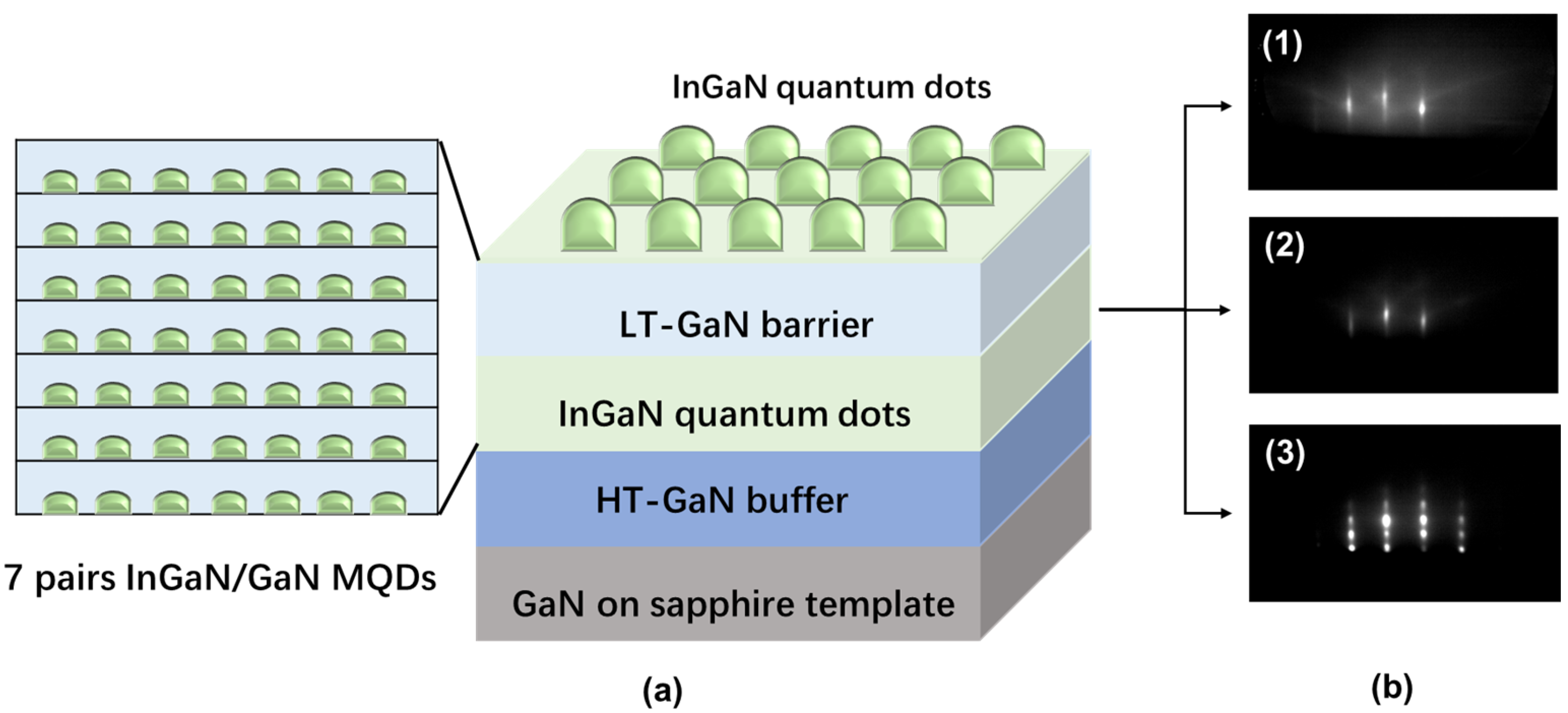
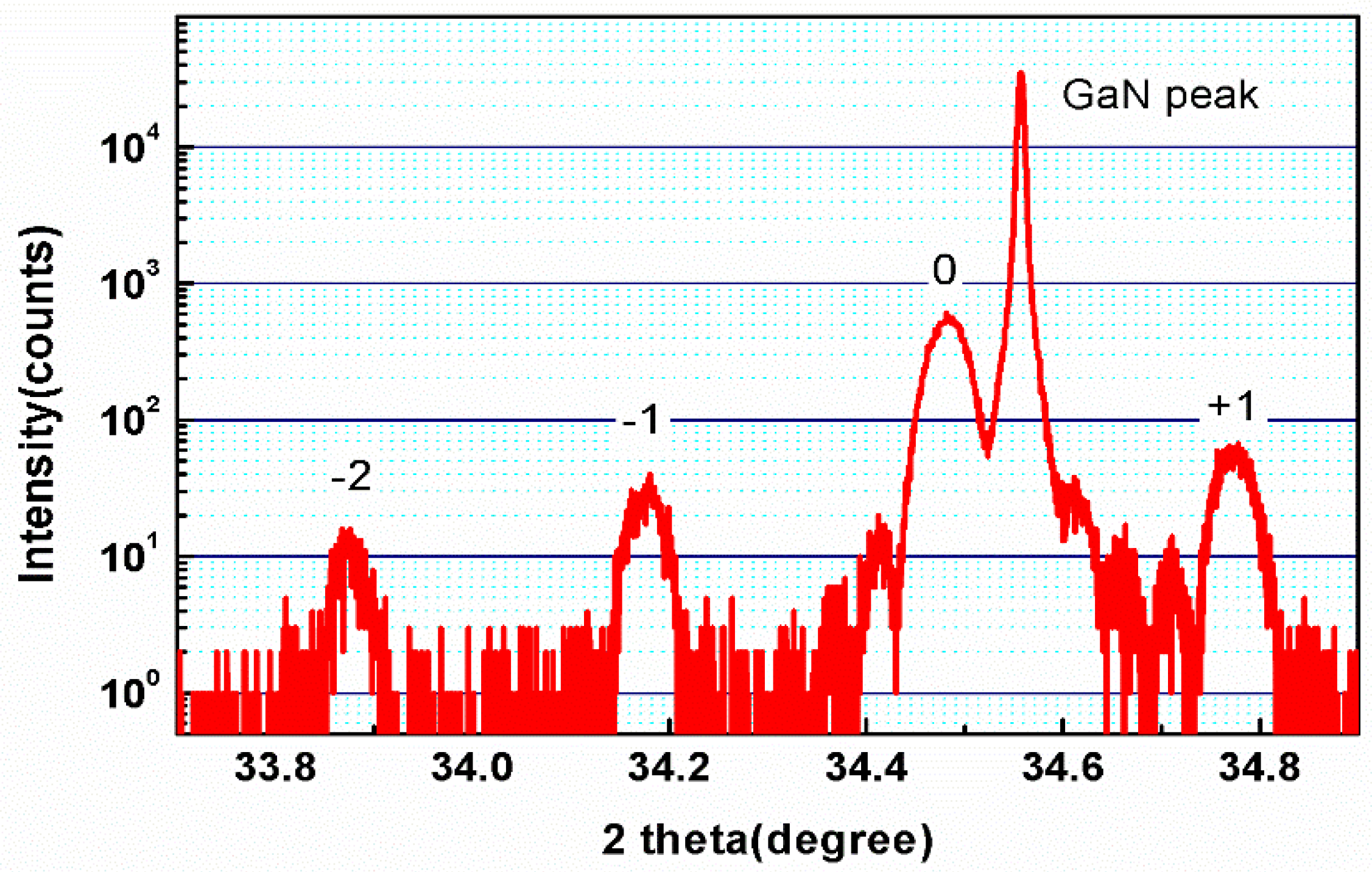
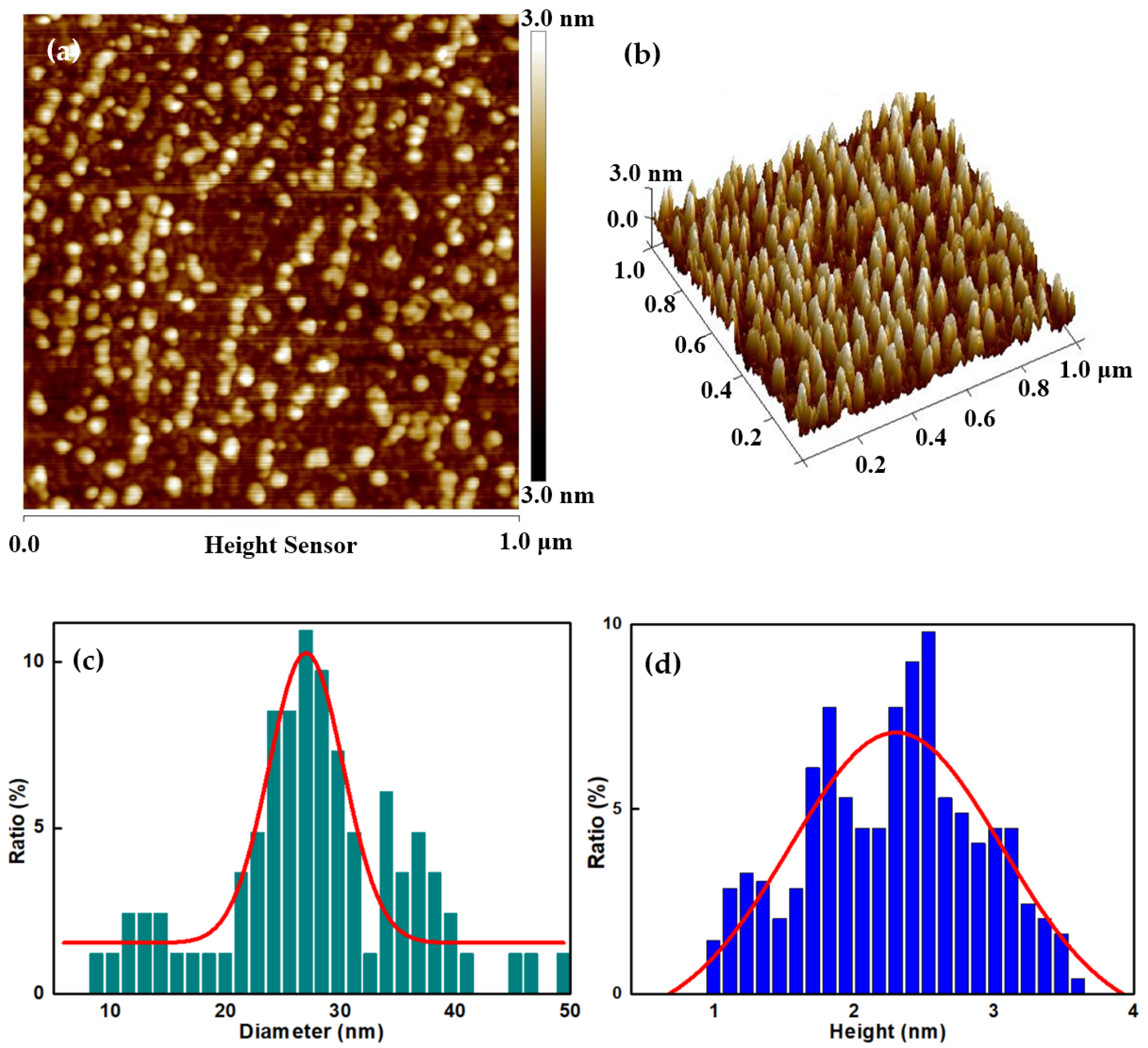

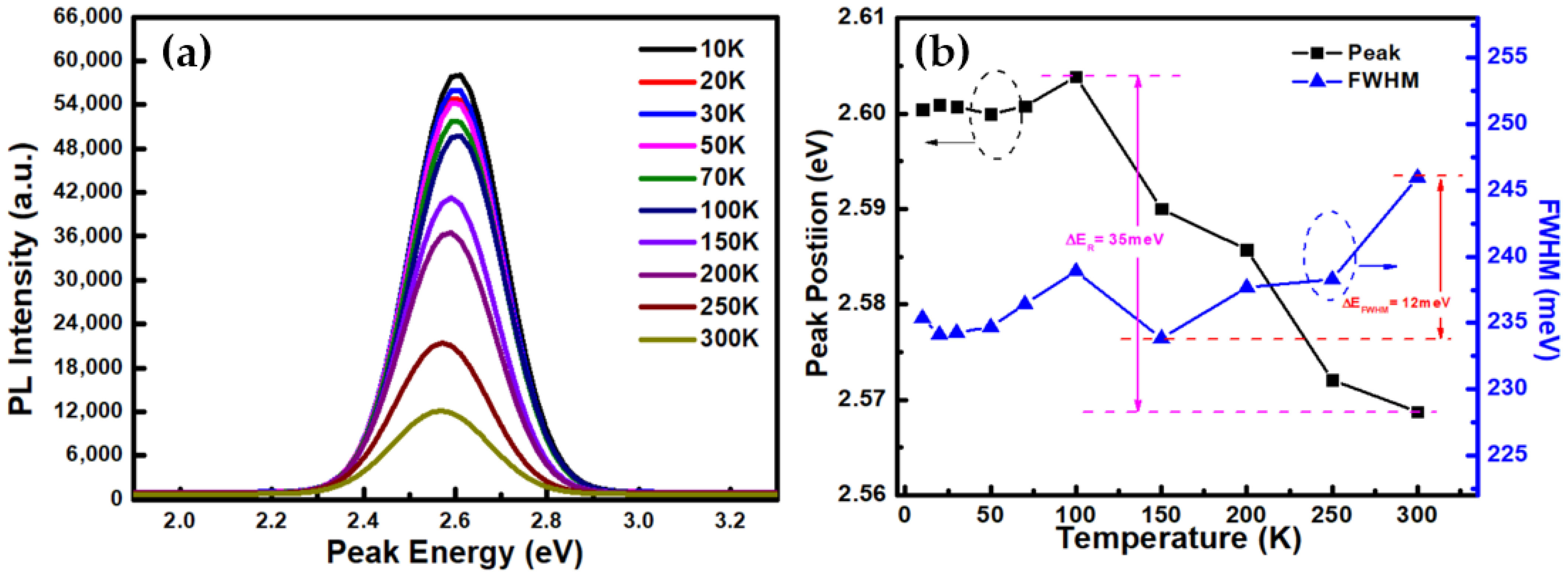
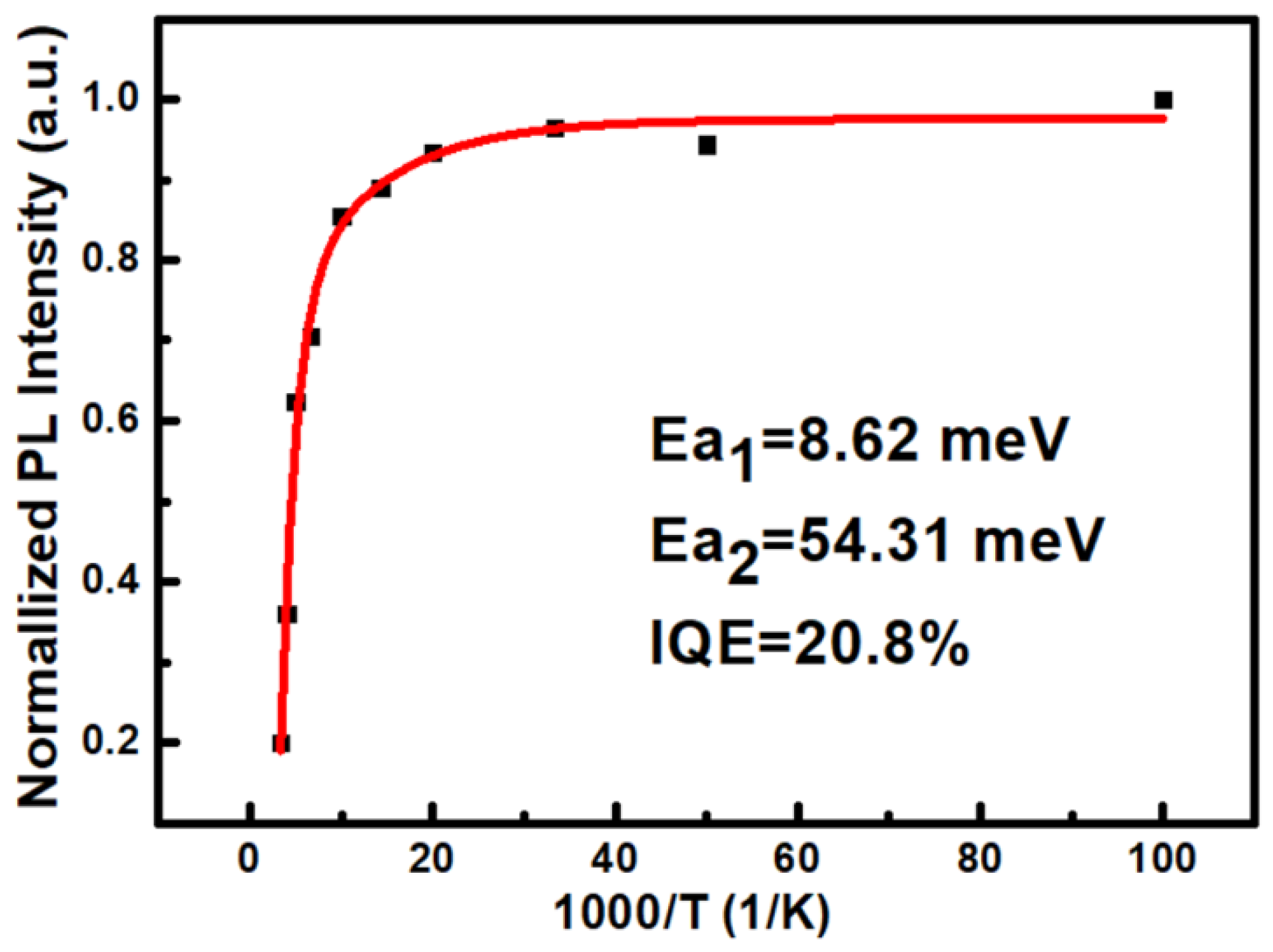
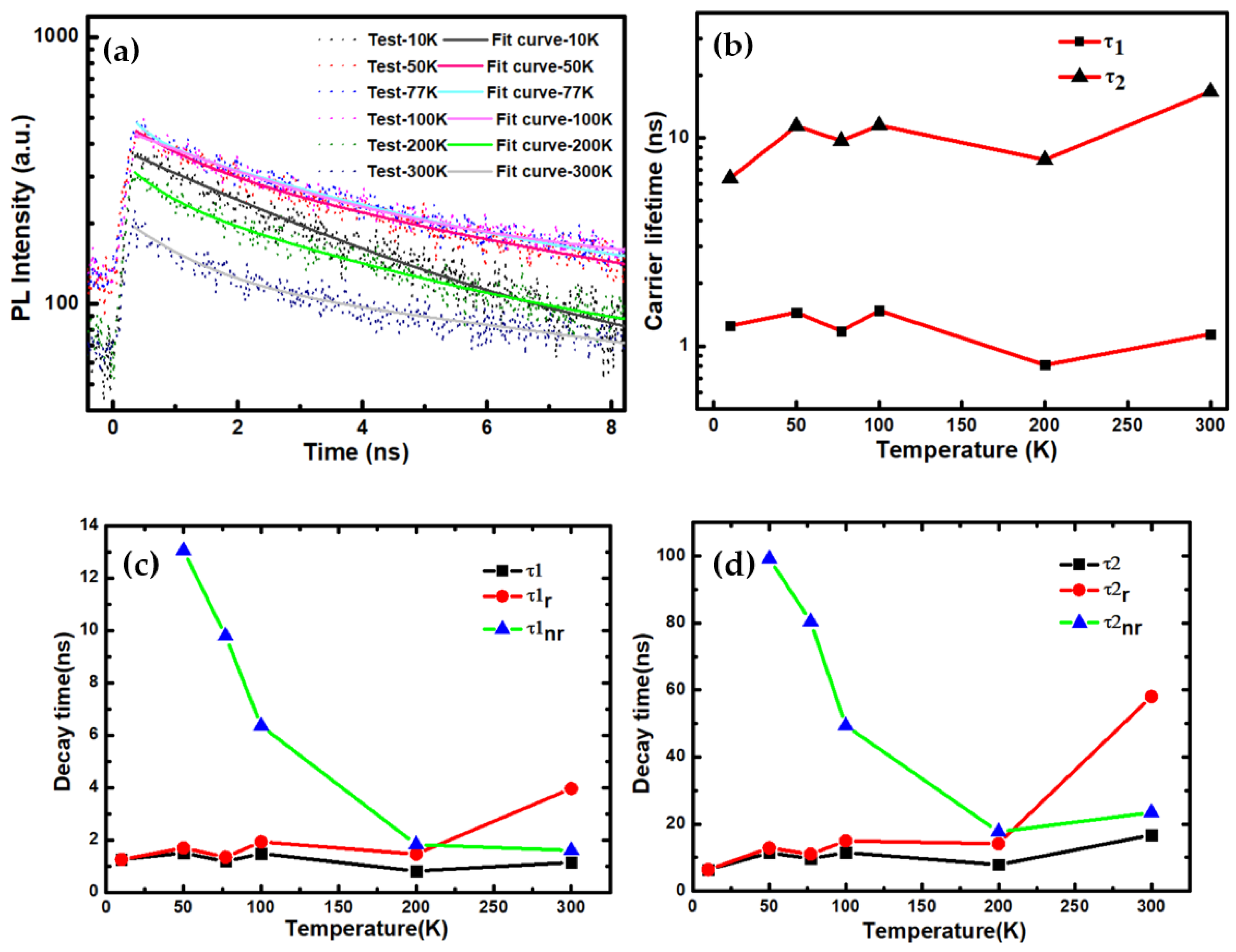
| Temperature (K) | 10 | 50 | 77 | 100 | 200 | 300 |
|---|---|---|---|---|---|---|
| τ1 (ns) | 1.25 | 1.5 | 1.18 | 1.48 | 0.81 | 1.14 |
| τ2 (ns) | 6.41 | 11.4 | 9.7 | 11.49 | 7.86 | 16.7 |
| A1:A2 | 16:84 | 41:59 | 34:66 | 36:64 | 36:64 | 48:52 |
Publisher’s Note: MDPI stays neutral with regard to jurisdictional claims in published maps and institutional affiliations. |
© 2021 by the authors. Licensee MDPI, Basel, Switzerland. This article is an open access article distributed under the terms and conditions of the Creative Commons Attribution (CC BY) license (https://creativecommons.org/licenses/by/4.0/).
Share and Cite
Zhang, X.; Yang, W.; Xing, Z.; Qiu, H.; Gu, Y.; Bian, L.; Lu, S.; Qin, H.; Cai, Y.; Suzuki, Y.; et al. Investigation of Micromorphology and Carrier Recombination Dynamics for InGaN/GaN Multi-Quantum Dots Grown by Molecular Beam Epitaxy. Crystals 2021, 11, 1312. https://doi.org/10.3390/cryst11111312
Zhang X, Yang W, Xing Z, Qiu H, Gu Y, Bian L, Lu S, Qin H, Cai Y, Suzuki Y, et al. Investigation of Micromorphology and Carrier Recombination Dynamics for InGaN/GaN Multi-Quantum Dots Grown by Molecular Beam Epitaxy. Crystals. 2021; 11(11):1312. https://doi.org/10.3390/cryst11111312
Chicago/Turabian StyleZhang, Xue, Wenxian Yang, Zhiwei Xing, Haibing Qiu, Ying Gu, Lifeng Bian, Shulong Lu, Hua Qin, Yong Cai, Yuta Suzuki, and et al. 2021. "Investigation of Micromorphology and Carrier Recombination Dynamics for InGaN/GaN Multi-Quantum Dots Grown by Molecular Beam Epitaxy" Crystals 11, no. 11: 1312. https://doi.org/10.3390/cryst11111312
APA StyleZhang, X., Yang, W., Xing, Z., Qiu, H., Gu, Y., Bian, L., Lu, S., Qin, H., Cai, Y., Suzuki, Y., Kaneko, S., Matsuda, Y., Izumi, S., Nakamura, Y., & Tackeuchi, A. (2021). Investigation of Micromorphology and Carrier Recombination Dynamics for InGaN/GaN Multi-Quantum Dots Grown by Molecular Beam Epitaxy. Crystals, 11(11), 1312. https://doi.org/10.3390/cryst11111312






